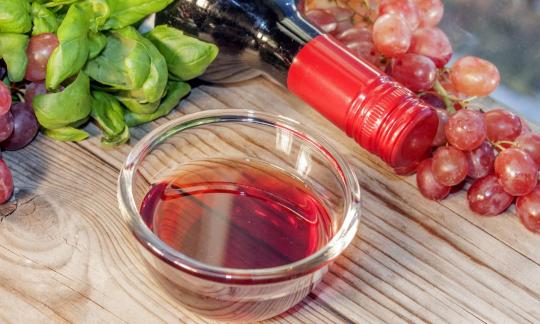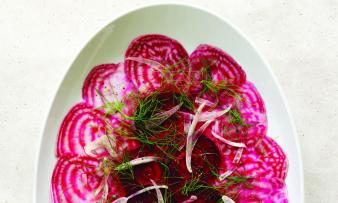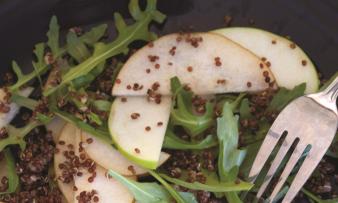Table of contents
Red wine vinegar goes well with salads when eaten raw. It can also be used to season sauces and soups. Organic quality is preferable.
Use in the kitchen
Red wine vinegar is vinegar made from red wine . It has a spicy, fruity-tart taste with a pronounced but pleasant acidity. It is used in the kitchen mainly as a seasoning.
It tastes excellent in dressings for a variety of salads, such as a Mediterranean potato salad (with dried tomatoes, olives, yellow bell peppers and red onions ), radish salad, tomato salad with green beans, lentil and rocket salad or a pear and rocket salad with quinoa . Red wine vinegar is also suitable for preserving and pickling raw vegetables and fruit. Red vinegar is also often used for preparing red cabbage and for marinating vegetables - the vegan Chioggia beetroot carpaccio is recommended. Pasta and hearty, vegan dishes with meat alternatives benefit from the aromatic, sour taste of red wine vinegar. Soups (e.g. Menorcan cream of vegetable soup ) and sauces (e.g. vegan gravy) can also be enhanced with a dash of red wine vinegar.
Red wine vinegar is also suitable for preparing unusual drinks and non-alcoholic soft drinks. A spritzer with sparkling water and 1-2 tablespoons of vinegar is a good thirst quencher. 1
Is red wine vinegar raw? This depends on how the red wine used is produced and on whether the red wine vinegar has been pasteurized. Unpasteurized red wine vinegar made from raw red wines (not heated above 42 °C) is considered raw. Whether red wine vinegar is vegan depends on how the red wine used was filtered - read more about this in the red wine article.
Homemade
red wine vinegar can be made in a variety of ways. To make it with vinegar essence, you need 200 ml of red wine (e.g. leftover wine), 200 ml of water and 50 ml of vinegar essence. Pour everything into a glass bottle or screw-top jar, close it and shake well so that the ingredients mix. Place the container in a dark, cool place and let the red wine vinegar mature for about a week. Pour into smaller, boiled bottles and store in a cool, dark and dry place.
Vegan recipe for shallots preserved in red wine vinegar
Ingredients (for 3 jars of 400 ml each): 750 g shallots, 5 cloves of garlic, 2 sprigs of rosemary, 100 g sugar, 125 ml red wine vinegar (preferably raw and organic), 350 ml red wine, 2 bay leaves .
Preparation: Peel the shallots and onions. Rinse the rosemary sprigs and shake them dry. Melt the sugar in a saucepan over medium heat, add the shallots and stir them in. Pour in the red wine vinegar and red wine. Add the rosemary and bay leaves. Cover the pan and simmer over low heat for 12-15 minutes. Fill the shallots and their liquid into hot-rinsed preserving jars (twist-off jars). Close them immediately and leave them on the lid for about 5 minutes. After about 3 days, the vegan preserved shallots are ready to eat. The shelf life is about 8 weeks if stored in a cool place. Store opened jars in the refrigerator.
Vegan recipes with red wine vinegar can be found under the note: " Recipes that have the most of this ingredient ".
| Not only vegans or vegetarians should read this: Vegans often eat unhealthily. Avoidable nutritional errors . |
Purchasing - Storage
Red wine vinegar can be bought in many supermarkets (e.g. Coop, Migros, Denner, Volg, Spar, Rewe, Edeka, Billa ). Aldi, Lidl and Hofer only offer it during special weeks. Organic quality wine vinegar is available in organic supermarkets (e.g. Denn's Biomarkt, Alnatura ).
Some conventionally produced red wine vinegars contain added antioxidants (such as potassium metabisulfite), which should be clearly stated on the packaging. Organic products do not contain such additives. 1 There are also pasteurized vinegars and natural, unheated vinegars. You can also find red wine vinegars enriched with fruit juice concentrate (e.g. raspberry juice concentrate) on the market.
The availability of red wine vinegar varies depending on the size of the store, catchment area, etc. You can find our recorded food prices for the DA-CH countries above under the ingredient image - and by clicking you can see their development at various suppliers.
Storage tips
Red wine vinegar will last for years if stored in an airtight container in a dark, cool place. If the vinegar smells musty, mold spores may have formed on the surface of the vinegar and it should be thrown away.
Since natural wine vinegar consists of living bacteria, these can multiply at warmer storage temperatures and form a mother of vinegar, a gelatinous mass of acetic acid bacteria. It is completely harmless to health - it is used in traditional vinegar production to "inoculate" starting liquids in order to speed up the conversion of alcohol to vinegar. 1 If you don't want to eat the mother of vinegar, you can simply remove it with a sieve.
Ingredients - Nutritional values - Calories
The energy content of red wine vinegar is 19 kcal per 100 g. There are hardly any carbohydrates (0.27 g/100g) or proteins (0.04 g/100g). The proportions of fat and fiber are negligible. 2 Vitamins, minerals and trace elements are relatively sparsely represented in red wine vinegar.
0.45 mg of iron are contained in 100 g of red wine vinegar - that is only 3% of the daily requirement. The content is comparable to that of other vinegars, such as apple cider vinegar (0.2 mg/100g), white wine vinegar (0.4 mg/100g), rice vinegar (0.5 mg/100g),herbal wine vinegar (0.6 mg/100g) and balsamic vinegar (0.72 mg/100g). Dried herbs (eg thyme : 124 mg/100g, basil : 90 mg/100g) are particularly rich in iron. 2 However, only small amounts are used.
Red wine vinegar contains 39 mg of potassium per 100 g (2% of the daily requirement). White wine vinegar (71 mg/100g) and apple cider vinegar (73 mg/100g) have similar amounts of the mineral. Dried seaweed contains a lot of potassium (eg kombu seaweed : 6100 mg/100g, dulse : 4684 mg/100g), but only small amounts should be consumed at a time due to the high iodine content. 2
100 g of red wine vinegar contains 0.05 mg of manganese (2% of the daily requirement). Other vinegars contain slightly more manganese, such as balsamic vinegar (0.13 mg/100g), white wine vinegar (0.16 mg/100g), rice vinegar (0.2 mg/100g), herbal wine vinegar (0.25 mg/100g) and apple cider vinegar (0.25 mg/100g). Pine nuts are a good source of manganese, with 8.8 mg/100g. 2
In addition to the main compound, acetic acid, wine vinegar contains various organic acids, esters, lactones, ketones, aldehydes, alcohols and acetals that contribute to its organoleptic properties. 3,4 Ethyl furoate, ethyl benzoate and limonene are volatile compounds detected in wine vinegar. 4 The phytochemicals present in wine vinegar include phenols, including phenolic acids (caftaric acid, gallic acid, ferulic acid, caffeic acid), anthocyanins, proanthocyanidins, flavanols (catechins, flavan-3-ols), stilbenes and tyrosol. 4,5,6,7
The complete ingredients of red wine vinegar, the coverage of the daily requirement and comparison values with other ingredients can be found in our nutrient tables. In the article Nutrients explained you will get a detailed insight into the topic.
Health effects
Vinegar has been shown to have a variety of functional properties, including antibacterial, anti-infective, antihypertensive, antioxidant and anti-cancer effects. Vinegar is also said to regulate fat metabolism, promote digestion, improve blood sugar levels, reduce the effects of diabetes and prevent cardiovascular disease. 3, 8,10,14
The antibacterial and anti-infective properties of vinegar are mainly due to the presence of organic acids, although polyphenols also contribute to these properties. Phenolic compounds (influenced by the raw material and fermentation conditions) are responsible for the antioxidant activity of vinegar. The effects of some vinegars on controlling blood sugar levels, regulating lipid metabolism and weight loss are attributed to acetic acid. Some types of vinegar inhibit the growth of cancer cells. However, these results were obtained primarily from cell and animal studies and the identity of the responsible ingredients remains largely unclear. 8 The results of a 2010 study indicate that the production method of vinegar has an impact on its bioactive compounds and thus functional properties. For example, the content of catechin and epicatechin in industrial vinegar was higher than that in traditional vinegar. 9
Is red wine vinegar healthy? A 2019 study examined the effects of daily red wine vinegar intake for 8 weeks on glucose homeostasis (blood sugar regulation) and obesity (severe overweight). Although vinegar supplementation led to a significant improvement in glucose homeostasis, a reduction in obesity was not observed. 11
In the early 2000s, drinks made from red wine vinegar and grape juice were developed. A 2003 study (using rats) examined the drink's cardiovascular effects. These results suggest that the drink may be useful for people concerned about heart palpitations and/or high blood pressure. 12 A 2005 study found a blood pressure-lowering effect and suggested that the drink may be useful in preventing various cardiovascular diseases. 13 In 2018, the drink was shown to have an effect on improving intestinal transit, which could be helpful for constipation. 15
Dangers - Intolerances - Side effects
We advise against excessive consumption of vinegar. This can cause health problems. High levels of potassium, sodium and bicarbonate in the urine and stimulation of plasma renin activity in the blood plasma have been observed in people who have consumed large quantities of vinegar over a long period of time. In one case, a patient who consumed around 250 ml of vinegar (12.5 g of acetic acid) daily had to be hospitalized with hypokalemia (disturbance of the electrolyte balance). There have also been reports of injuries to the mucous membranes of the mouth and esophagus caused by vinegar and chemical burns to the skin caused by the use of vinegar to treat skin diseases. 10
Acidic foods and drinks, including red wine vinegar and red wine, can soften the tooth structure and thus cause tooth erosion. Only consume such products in moderation, avoid brushing your teeth immediately before and after consumption and use a fluoride rinse afterwards or eat a sugar-free yogurt to neutralize the acid and remineralize. 16
Folk Medicine - Natural Medicine
Hippocrates (460-377 BC) recommended vinegar for cleaning ulcers and treating wounds. He, his contemporaries, and even today's doctors prescribed oxymel, a popular ancient medicine made from honey and vinegar (usually white wine vinegar ), for stubborn coughs. In the 8th century, Japanese samurai warriors used vinegar as a tonic, believing that vinegar tonic gave them strength and power. Sung Tse, the founder of forensic medicine in the 10th century, advocated washing hands with sulfur and vinegar to prevent infections during autopsies. Writings by American doctors from the late 18th century show that they used vinegar to treat many diseases, from dropsy to croup to stomach pain. Before the manufacture and marketing of blood sugar-lowering drugs, diabetics drank "vinegar teas" to relieve their chronic suffering. 3.17
Today, vinegar is used in various coastal towns around the world as an immediate treatment after a jellyfish sting, as vinegar deactivates the nematocysts. However, a bath in hot water is considered the most effective first-line treatment for a jellyfish sting and for inactivating the venom. The media also recommends vinegar for treating nail fungus, head lice and warts, but there is no scientific basis for these treatment strategies. Experts also advise against using vinegar preparations to treat wounds or as a household disinfectant. 17
Ecological footprint - animal welfare
The CO 2 footprint is the primary means of assessing the climate friendliness of a food product. This depends on various aspects, such as the cultivation method (conventional/organic), seasonality, country of origin, processing, transport and, if applicable, packaging. According to CarbonCloud, the production of 1 kg of Italian red wine vinegar causes 0.61 kg CO 2 eq and that of 1 kg of French red wine vinegar causes 0.63 kg CO 2 eq. 18,19 However, according to The Big Climate Database, the CO 2 footprint of 1 kg of red wine is 1.74 kg CO 2 eq. 20
We found no information on the water footprint of red wine vinegar, but we did find information on that of wine. Approximately 870 l of water are needed to produce 1 kg of wine. 21
In conventional agriculture, synthetic pesticides are often used to combat unwanted plants and insects. These have been proven to have a negative impact on the environment and affect important pollinators, birds and mammals, among others. Accordingly, when buying red wine vinegar, you should choose organic products in order to protect biodiversity and your own health, among other things. The use of such pesticides is prohibited in organic farming.
Detailed explanations of various sustainability indicators (such as ecological footprint, CO2 footprint, water footprint) can be found here .
Worldwide occurrence - cultivation
The production of vinegar dates back to at least 200 BC. Since early antiquity, vinegar has been part of the human diet, as a seasoning and preservative, and as a basis for simple medicinal products. 7
As a rule, wine-producing countries are also important producers of wine vinegar. This is especially true for countries with warmer climates, as acetic acid bacteria require high temperatures to develop. Red wine vinegar is produced mainly in Mediterranean countries using different methods that result in products of very different quality. 4
Industrial production
There are two main processes in the production of vinegar: alcoholic fermentation (in the presence of yeasts, e.g. Saccharomyces cerevisiae ) and acetic acid fermentation (by acetic acid bacteria). In alcoholic fermentation, yeasts convert sugar into alcohol (ethanol) under anaerobic conditions. During acetic acid fermentation, the aerobic acetic acid bacteria convert alcohol into acetic acid. 3,4,22 Acetic acid fermentation is not actually fermentation, as this process requires oxygen, but rather an incomplete oxidation or fermentation. 23
The methods of producing vinegar from wine range from traditional, slow processes using wooden barrels and surface cultures (Orléans process) to industrial, fast methods using submerged bacterial cultures (e.g. submerged process). 3,4,5
The Orléans process is one of the oldest techniques for producing vinegar. 3 The acetic acid bacteria are placed on the surface of the vinegar-forming liquid (red wine in the case of red wine vinegar). The conversion of ethanol into acetic acid therefore takes place through a so-called surface culture at the interface between the liquid and the air. Wooden barrels with side openings for air circulation are used for the Orléans process. 5, 7 The vinegars obtained in this way are of very high quality due to their sensory properties and are therefore usually expensive. 3,4, 5,7
Large quantities of vinegar require industrial, rapid methods. In these, the acetic acid bacteria cultures are immersed (directly or on a device) in the alcohol-containing liquid, but the oxygen demand is guaranteed. These "submersion" methods increase the speed of the conversion of ethanol to acetic acid. 4, 5 One such method is the submerged process, which is usually used for the industrial production of wine vinegar. The acetic acid bacteria are located directly in the liquid in a closed container. Turbines provide the required oxygen supply by blowing air bubbles into the liquid. The oxidative process by the bacteria takes place at the air-liquid interfaces of the air bubbles. 3,7
The longer fermentation time of traditional methods allows the build-up of a non-toxic slime made up of yeast and acetic acid bacteria known as the mother of vinegar. Many producers filter and pasteurize their product before bottling to prevent the formation of these organisms. After opening, stored, unpasteurized vinegar may form a mother of vinegar, which can be removed by filtering. 17
Further information
According to a legend, a courtier in Babylonia (ca. 5000 BC) "discovered" wine, formed from unattended grape juice, which eventually led to the discovery of vinegar and its use as a preservative. In ancient times, vinegar was still considered a by-product that was created when wine spoiled through contact with air. Today, vinegar is a common and widely consumed food. Vinegar, from the French vin aigre, which means something like "sour wine", can be made from almost any fermentable carbohydrate source, such as wine, molasses, apples, grapes, grain, but also from coconuts, melons, honey or beer. A distinction is made between vinegars made from fruit juices and vinegars made from plant-based raw materials. 3,17
In the United States, vinegar products must have an acidity of at least 4%, while in Europe there are regional standards for vinegar. White spirit vinegars typically contain 4-7% acetic acid, while apple cider vinegar and wine vinegar contain 5-6% acetic acid. The alcohol content of wine vinegars is 1.5% vol., while that of other vinegars is 0.5% vol. 17,24
Special vinegars are divided into herbal and fruit vinegars.Herbal vinegars consist of wine vinegar or white spirit vinegar, which can be flavored with garlic, basil, tarragon, cinnamon, cloves or nutmeg, for example. Fruit vinegars are wine vinegars and white vinegars that are sweetened with fruit or fruit juice to create a sweet and sour taste. Traditional vinegars are made from regional foods according to traditional customs. The balsamic vinegar from Modena, Italy, is made from the local white Trebbiano grapes, which are harvested as late as possible, slowly fermented and concentrated by aging in barrels made of various types of wood. Traditional rice wine vinegars are produced in Asia, coconut and cane vinegar are common in India and the Philippines, and date vinegar is popular in the Middle East. 17
Are red wine vinegar and balsamic vinegar the same? Balsamic vinegar, mostly from Modena (Aceto Balsamico di Modena), is made by mixing cooked and/or concentrated grape must, at least 10% wine vinegar, a small amount of vinegar aged for 10 years and sometimes caramel coloring (up to 2%). 24 Red wine vinegar is made by fermenting red wine . Balsamic vinegar is sweeter than wine vinegar and has a lower acid content.
You can also find detailed articles about the following vinegars: white balsamic vinegar, white wine vinegar ,herbal wine vinegar, apple cider vinegar and rice vinegar .
Alternative names
In English, red wine vinegar (also red wine vinegar) is called red wine vinegar, in Spanish it is called vinagre de vino.
Other uses
Vinegar is an effective cleaning agent that is used primarily for descaling. However, white vinegar (table vinegar) is better suited for this than red wine vinegar.
Bibliography - 24 Sources (Link to the evidence)
| 1. | Pini U. Das Bio-Food Handbuch. Ullmann Verlag: Potsdam; 2014: 186. |
| 2. | USDA United States Department of Agriculture. |
| 3. | Ho CW, Lazim AM et al. Varieties, production, composition and health benefits of vinegars: A review. Food Chemistry. 2017;221:1621–1630. |
| 4. | Callejón RM, Tesfaye W et al. Volatile compounds in red wine vinegars obtained by submerged and surface acetification in different woods. Food Chemistry 2009;113(4):1252–1259. |
| 5. | Cerezo AB, Tesfaye W et al. The phenolic composition of red wine vinegar produced in barrels made from different woods. Food Chemistry. 2008;109(3):606–615. |
| 6. | Cerezo AB, Cuevas E et al. Anthocyanin composition in Cabernet Sauvignon red wine vinegar obtained by submerged acetification. Food Research International. 2010;43(6):1577–1584. |
| 7. | Mas A, Torija MJ et al. Acetic acid bacteria and the production and quality of wine vinegar. The Scientific World Journal. 2014;2014:e394671. |
| 8. | Chen H, Chen T, Giudici P, Chen F. Vinegar Functions on Health: Constituents, Sources, and Formation Mechanisms. Comprehensive Reviews in Food Science and Food Safety. 2016;15(6):1124–1138. |
| 9. | Budak HN, Guzel-Seydim ZB. Antioxidant activity and phenolic content of wine vinegars produced by two different techniques. J Sci Food Agric. 2010;90(12):2021–2026. |
| 10. | Santos HO, de Moraes WMAM et al. Vinegar (Acetic acid) intake on glucose metabolism: A narrative review. Clinical Nutrition ESPEN. 2019;32:1–7. |
| 11. | Jasbi P, Baker O et al. Daily red wine vinegar ingestion for eight weeks improves glucose homeostasis and affects the metabolome but does not reduce adiposity in adults. Food Funct. 2019;10(11):7343–7355. |
| 12. | Sugiyama A, Saitoh M et al. Acute cardiovascular effects of a new beverage made of wine vinegar and grape juice, assessed using an in vivo rat. Nutrition Research. 2003;23(9):1291–1296. |
| 13. | Honsho S, Sugiyama A et al. A red wine vinegar beverage can inhibit the renin-angiotensin system: experimental evidence in vivo. Biological and Pharmaceutical Bulletin. 2005;28(7):1208–1210. |
| 14. | Budak NH, Aykin E et al. Functional properties of vinegar. Journal of Food Science. 2014;79(5):757-764. |
| 15. | Enkhsaikhan A, Takahara A et al. Effects of red wine vinegar beverage on the colonic tissue of rodents: biochemical, functional and pharmacological analyses. Biol Pharm Bull. 2018;41(2):281–284. |
| 16. | Zero DT, Lussi A. Erosion--chemical and biological factors of importance to the dental practitioner. Int Dent J. 2005;55(4 Suppl 1):285–290. |
| 17. | Johnston CS, Gaas CA. Vinegar: medicinal uses and antiglycemic effect. MedGenMed. 2006;8(2):61. |
| 18. | CarbonCloud: Red wine vinegar, Italy. 2024. |
| 19. | CarbonCloud: Red wine vinegar, France. 2024. |
| 20. | The Big Climate Database (Version 1.1): Wine, red. 2024. |
| 21. | Mekonnen MM, Hoekstra AY. The green, blue and grey water footprint of crops and derived crop products. Hydrol. Earth Syst. Sci. 2011;15:1577–1600. |
| 22. | Ho CQ, Fazry S et al. The Biochemistry of Vinegar Production. In: Bekatorou A, Hrsg. Advances in Vinegar Production. Vereinigtes Königreich: CRC Press; 2019:29-38. |
| 23. | Chemie de: Essigsäuregärung. |
| 24. | Giudici P, Lemmetti F, Mazza S. Balsamic Vinegars: Tradition, Technology, Trade. Springer International Publishing: Switzerland; 2015. |











Comments